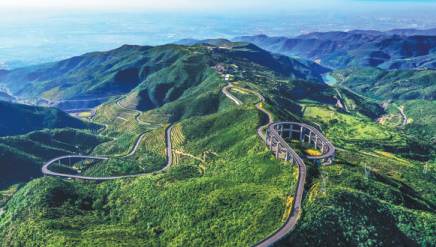
The Xishan Ecological and Cultural Tourism Demonstration Zone has emerged as a tourist attraction in Taiyuan over recent years. [Photo provided to China Daily]
Boasting 18 suburban forest parks and a high rate of vegetation, the Xishan Ecological and Cultural Tourism Demonstration Zone has emerged as a landmark tourist attraction in the Shanxi provincial capital of Taiyuan.
Its fame increased this year after it was recognized by the Ministry of Ecology and Environment in October as an experimental base for the practices of "turning green mountains and clear waters into valuable assets".
Green mountains and clear waters feature in today's Xishan demonstration zone. Local statistics show that, over the past decade, trees have been planted across 13,000 hectares.
But the scene was different a decade ago. Xishan, which literally means Western Mountains, used to be a major coal-mining site and a coal refuse dumping field in Taiyuan.
When recalling what it was a decade ago, Ji Lei, an executive of Baijiazhuang Coal Mine, said: "There was a huge coal refuse dumping field in Xishan, with an area of more than 1.7 square kilometers. Baijiazhuang was among the four coal mines that dumped gangue – worthless coal mine rock – here."
He added it was also a major source of pollution, with wastewater from coal washing, dust and hazardous gas emitted from the spontaneous burning of gangue.
"What you could see on the ground was just the 'tip of the iceberg'," Ji said. "Under the ground was a mining subsidence area of 120 sq km."
In addition, the neighboring area had gathered more than 2,000 polluting enterprises, especially those engaged in coal mining, electricity, coking and chemistry.
"When the environmental deterioration reached an unbearable level, we realized it was time to transform," Ji said.
The local government began to take action in the early 2010s. Mines like Baijiazhuang were relocated, together with another 2,000-plus polluting enterprises being shut down or relocated.
On the former mining sites and dumping fields, ecological repair and greening moves have been going on for more than a decade.
In the process of greening, a forestry worker recalled that the hardest part was to plant trees on gangue dumping fields and mine-damaged slopes.
"When planting seedlings, we put them in seedling-cultivating pipes made from degradable biomaterials to help the roots reach the depth of the soil," he said.
After more than 10 years of efforts, the vegetation coverage of the Xishan demonstration zone reaches 86 percent, compared with the original rate of less than 20 percent, according to local statistics.
The zone has once again become a tourism hub in Taiyuan. Old attractions, like the neighboring Jinci Temple and Tianlingshan Grottoes, have stepped out from the shroud of coal dust and are shining again.
There are also new attractions, like the Taiyuan Botanical Garden standing on the former premises of coal-producing companies.
Local statistics show that the Xishan demonstration zone received 8.42 million visits during the first nine months of this year, growing 111.8 percent year-on-year.
Meng Ting contributed to this story.
